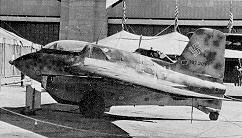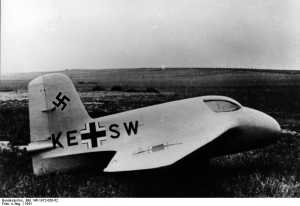Messerschmitt Me 163 Komet
German Rocket-powered Interceptor of WW2
By Stephen Sherman, Dec. 2008. Updated July 7, 2011.
Stubby. Every article one reads about the Me 163 calls it "stubby." It wasn't that small a plane, with about the same wingspan as Bf 109, but with a fuselage less than two-thirds of that length, it was an odd looking aircraft indeed; its tremendous power belying its resemblance to a cartoon or toy airplane.
The German Me 163, a rocket-powered defensive fighter, was one of the most unusual aircraft of World War II. Fortunately, its potential impact was minimized by technical problems and the small number produced.
It was also unusual in that it had no horizontal tail surfaces nor any wheeled landing gear. Control was provided by elevons and landings were made on a retractable skid, while a detachable trolley was used for take-off.
History
As early as 1938, Dr. Alexander Lippisch, a pioneer in glider research, had developed an airframe for the rocket-propelled craft, when the project was moved under the Messerschmitt company, and called the Me 162. The first Me 163A prototypes were tested in Augsburg in 1941. Then, powered flight tests were moved to Peenumunde on the Baltic Coast for security reasons. Test pilot Heini Dittmar made the first 'sharp' start on August 13 of that year.
The Me 163 was incredibly fast, and on October 2, reached the 1,000 KPH (621 MPH) figure. The Luftwaffe promptly ordered seventy of them, but, with the war looking favorable for Germany at that time, the Me 163 was not seen as a priority. Certainly none of the Nazi planners in late 1941 was contemplating the need for point-defense interceptors against American bombers hitting the Reich.
The fighter prototype, the Me 163B, was ready for flight trials in mid 1942, but the rocket motor was not available, so powered flight testing was delayed until August 1943. At that time an operational trial unit Erprobskommando16 (Ekdo 16) was formed, just four pilots under the command of Wolfgang Späte. All had been glider pilots before the war, an excellent background for the Me 163's planned flight operations. It was to launched, stay in the air for five to eight minutes until it used up all its fuel, and then glide back to base. As hazardous as this sounds, the gliding aspect of the Me 163 worked fairly well.
But, as with any new technology, there were difficult lessons to be learned. The rocket used two propellents (both quite unstable and corrosive), that when they came in contact with each other, exploded, thus powering the rocket. HTP hydrogen peroxide mixed with hydrazine hydrate makes quite a bang! Do not try this at home. The stuff burned off very rapidly, giving just a few minutes of flight. As there were no wheels, the Me 163 landed on a skid, which was a bumpy proposition. Any residual fuels left in the tanks would then combine and explode; several aircraft were lost in just this manner. Even by itself, the HTP was highly corrosive, especially to any organic materials, so the pilots had to wear protective suits of synthetic materials. But sometimes it seeped into the cockpit, or worked through the seams of the overalls. On occasion, an Me 163 would just blow up while sitting on the ground.
Production Me 163Bs were not ready for operational use until July 1944. The Luftwaffe planned to have small units of Komets dispersed to intercept Allied bomber formations, but only 279 Me 163Bs were delivered by the end of the war. The sole operational Komet group, JG 400, scored nine kills while losing 14 of its own aircraft.
Pictures
Some great pictures of the Me 163s:
- Photos courtesy of the National Museum of the US Air Force
- Mark Styling's excellent site of his artwork
Sources:
Aces of the Reich: The Making of a Luftwaffe Fighter Pilot, by Mike Spick, Greenhill Books, London, 2006
Illustrated Dictionary of Fighting Aircraft of World War II, by Bill Gunston, Salamander Books, London, 1988
Pictures and information courtesy of the National Museum of the US Air Force.



